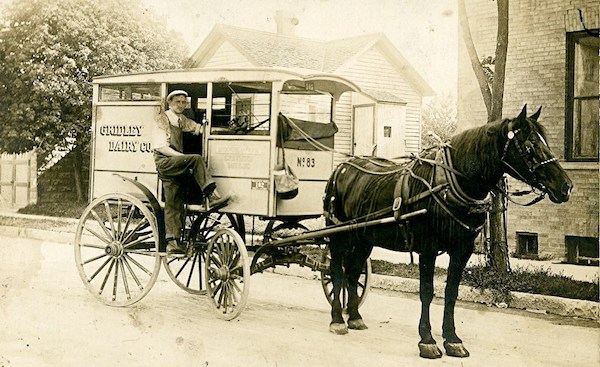Since the mid-1970s, most Americans have been buying their milk in cartons and plastic jugs. But long before mass manufacturing and modern packaging, milk was sold out of the back of horse-drawn wagons from open barrels and cans. Typically, a “milkman” would ladle the milk into whatever containers milk buyers brought with them, or people would leave them on their front stoop and the milkman would fill them up. This method of getting milk to town and city people worked well up until the late 19th century as urban populations began to explode amid the Industrial Revolution.
According to historians, the very first home milk deliveries in the US occurred in Vermont in 1785, and the practice spread from there. Local dairy farmers provided the milk and sometimes the delivery service as well. More often, deliveries were handled by middlemen who would go around collecting milk from various surrounding farms. These collections and deliveries had to be done every day because this was also before refrigeration.
Around the beginning of the 20th century, dairy farmers started adopting mechanized milking, and both farms and milk production grew. It was at this point that dairies began investigating better delivery practices. The very first documented use of glass milk jars was in 1879 by Echo Farms Dairy, which delivered milk to New York City from Litchfield, Connecticut. Some milk distributors were leery of breakage expenses so the practice was slow to catch on, but by the late 1800s, glass milk jars were fast becoming the standard.
The very first patented milk bottle is credited to Harvey D. Thatcher in 1884. While plenty of milk jars had been patented, Thatcher’s milk bottle was the first that included a cap. His cap invention was the ball-type closure known as a Quillfeldt stopper (sometimes called a swing-top or flip-top cap) that is affixed by wires. These same types of bottle closures are still used today by some beer and beverage makers.
Pre-refrigeration, milk had to be used quickly because of its short shelf life. That meant the milk bottles, which were delivered and picked up every day, got a lot of use. In the early 1900s, it is estimated that the typical milk bottle was 22.5 trips from the dairy and back before getting broken or lost.
On top of the hassle and cost of lost and broken bottles, the containers also had to be washed and sterilized after their return, which was another massive expense for dairies. There were also sanitary concerns regarding freshly filled, sanitized bottles being transported next to used, contaminated bottles. Additionally, unscrupulous milk dealers were known to open fresh bottles of milk, water it down, and split it among non-sanitized bottles.
The answer to these issues was single-use containers. Historians are less sure of when or who invented them, but the first waxed paper cartons in the US began to appear during the 1890s. They varied in shape and size. Most were simple boxes, but some mimicked the style of glass bottles, while others were cone- or pyramid-shaped.
In 1915, John Van Wormer, a toy manufacturer in Toledo, Ohio, was granted the first patent for a “paper bottle,” which was the first folded blank box for holding milk. Because the cartons could be thrown away instead of reused, Wormer called his product the “Pure-Pak.” He also created the machinery to make the cartons, which were delivered to dairies in flattened form.
Dairies preferred bottles because they effectively created a monopoly where they established their collection system. Cartons extended the range beyond the 20–30 miles over which a dairy could operate effectively with bottles. But cartons were much lighter and easier to transport, and enterprising companies began making the shift away from bottles. By the 1940s, glass bottles and paper containers had largely been replaced by rectangular, waxed paperboard cartons with the familiar gable-tops that are still common today.
The bulbous, plastic jugs that are also common today were invented by artist and designer Walter R. Bard. Made to hold large amounts of milk with the sanitary benefits of sealable screw top lids, the plastic jugs were easy to fill and sell in stores. Today, most milk in the US is sold in plastic jugs and waxed cardboard cartons. And of course, you have to go to a store to get it as the milkmen of old unfortunately disappeared with the rise of refrigeration.
Milk bottles have been popular collector’s items over the years, although I don’t know if there is really any money in them. Bottles can run anywhere from a couple of bucks to over $200 on eBay. About 20 years ago, it feels like they were pretty common at auctions but I don’t see many these days. I do know that some of the more collectible bottles are the ones from East Coast dairies that first adopted them, especially original Thatcher bottles. (Sources: National Museum of American History, National Association of Milk Bottle Collectors, Wired, Wiki)












What about flat top cartons with the corner lid, folded back to pour out and then pushed back in to seal it
Was there ever a clay milk bottle? I found one and I have no idea if it is authentic or reproduction home decoration. It is hand thrown was painted grey but someone removed all the paint except for in the top part of the neck. The bottom is also still grey paint. The front is a stamp in the clay which is red clay, no glaze now.